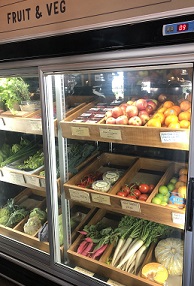A POST-HARVEST TECHNOLOGY COURSE FOR THE AGRICULTURE INDUSTRY
- An introduction to refrigeration engineering - theory and application - for farming.
Relevant to:
- Vegetables and Fruit
- Meat and Fish
- Cut Flowers and Herbs
- Seed, oil extracts and any other produce from a farm
Refrigeration does not just mean freezing; but it includes freezing.
Different produce is best treated in different ways. Fresh cut flowers or vegetables for instance can have their shelf life extended greatly by cooling , but depending on the product the temperature might only be 7, 8 or 10 degrees Celsius. Meats for instance may need to be cooled lower. Some produce can have the shelf life extended months by lower temperatures at or below freezing. You will learn about the different products and their treatments in this course.
Underpinning a knowledge of how to treat what, you will first learn about the engineering and physics behind refrigeration.
COURSE CONTENT

This course is broken into eight lessons as follows, studied over 100 hours.
- Nature and Scope of Refrigeration
- The Refrigeration Process
- The Vapour Compression System
- Heat Load Calculations
- The Refrigeration Cycle: Refrigerants and Components
- Applied Refrigeration: Farm Produce
- Applied Refrigeration: Other Products
- Freezing Goods
What is Refrigeration?
Refrigeration is the removal of heat from a space or a substance whether in the form of solids, liquids or gases in order to lower their temperature. Usually goods are refrigerated to between 3 and 7°C and some goods have an ideal storage temperature. More specifically, refrigeration is the process of removing heat energy from a low temperature reservoir and transferring it to a higher temperature reservoir. The process is cyclical in nature meaning that it repeats itself. The heat transfer work is generally driven by mechanical means however it can also be driven by heat, magnetism, electricity, sound or other means.
Refrigeration has many applications ranging from domestic household refrigerators to larger industrial refrigerators/freezers and cryogenics.
Why do it?
Many food products can become spoiled because of the internal chemical reactions that can cause ripening, fermentation and the growth of certain moulds and bacteria. These processes can be stopped altogether or slowed down significantly by the storage at low temperatures. The optimum storage temperature varies between the different kinds of products. In order to preserve moisture within products, many are stored and chilled in areas where the humidity is kept at a high level. This ensures that moisture is retained in the air and avoids excessive moisture loss from the product.
Once produce is harvested it deteriorates quickly unless it can be promptly placed in a cool environment. Transportation from farm cool rooms to the food markets or food processors also causes deterioration - if the produce isn’t handled and cooled correctly. Refrigerated transport vehicles are very commonly used for this purpose. Refrigeration, therefore, has a high impact in society and industry today due to the need to preserve items of food or produce to enable transport to take place over long distances and duration and to keep products at peak freshness. This preservation prevents the spoilage of items for extended periods of time.
- Fruits and vegetables are generally stored at temperatures above their freezing point with the aim being to prolong their life by days/weeks. In this scenario, the decaying process is slowed down but not completely stopped.
- Some meats, fish and precooked items are stored at temperatures below their freezing point and only defrosted when they are to be used by the consumer. In this scenario, the decay process is stopped completely.
- Freezing food is also common and one of the most effective techniques that can preserve the colour and flavour of some fresh products making them more appealing to consumers.
UNIQUE HYBRID COURSE
This course is very much a hybrid course - half is about understanding the basic engineering that underpins refrigeration, and the other half is about the produce and how to treat it.
The ability to properly use refrigeration can add great value to farm produce, increasing durability, shelf life and quality. To fully benefit from using refrigeration in the agricultural sector, it is important to understand both the post harvest management of farm produce, and also the technology that is used.
Who Is This Course Suitable For?
This course is suitable for farmers, farm workers, food , food processors, caterers and food sellers.
It provides you with a significant career advantage by understanding how to refrigerate farm produce effectively.
Why Study This Course?
If you would like to improve your job and career prospects in the area of food storage and preservation, then this is the course for you.
The course is self-paced. We do not set deadlines, so you can work at your own pace to fit in around you and your lifestyle.
The course is studied online or by e-learning, so you can study where you want.
All of our tutors are industry experts and are there to help you throughout the course, marking your assignments and answering any questions.
Any Questions Before You Get Started?